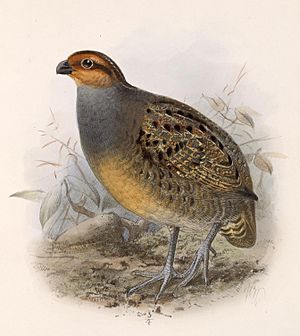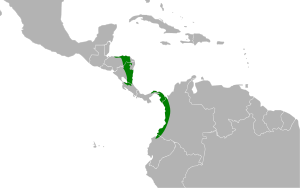Tawny-faced quail facts for kids
Quick facts for kids Tawny-faced quail |
|
|---|---|
 |
|
| Conservation status | |
| Scientific classification | |
| Genus: |
Rhynchortyx
|
| Species: |
cinctus
|
 |
|
The tawny-faced quail (Rhynchortyx cinctus) is a small, shy bird that lives in the forests of Central and South America. It's part of the New World quail family. You can find this bird in countries like Colombia, Costa Rica, Ecuador, Honduras, Nicaragua, and Panama.
Contents
About the Tawny-faced Quail Family
The tawny-faced quail is special because it's the only bird in its group, called Rhynchortyx. Think of it like a unique branch on a family tree! There are three slightly different types, or subspecies, of the tawny-faced quail:
- R. c. cinctus (the main type)
- R. c. pudibundus
- R. c. australis
What Does the Tawny-faced Quail Look Like?
This quail is about 17 to 20 centimeters (7 to 8 inches) long. That's about the size of a small ruler! A male bird can weigh around 165 grams (5.8 ounces).
Male and Female Differences
- Males: They have a reddish face with a black stripe going through their eye. Their head and the back of their neck are dark brown. Their back is gray to brown with black stripes. Their throat and upper chest are gray, and the rest of their belly is a warm, yellowish-brown color.
- Females: They look similar but are generally browner. Their head and back are dark brown, and their rump (the area above the tail) has mixed brown and reddish-brown colors. Their face and upper chest are reddish-brown, but their eye-line, chin, and throat are white. The lower chest and belly are pale with black stripes.
Subspecies Variations
- The R. c. pudibundus type is usually paler (lighter in color).
- The R. c. australis type is generally darker.
Where the Tawny-faced Quail Lives
The tawny-faced quail lives in different areas that are not connected.
- The main type, R. c. cinctus, lives in Costa Rica and Panama.
- The R. c. pudibundus type is found in northeastern Honduras and eastern Nicaragua.
- The R. c. australis type lives along the Pacific coasts of Colombia and the very northern part of Ecuador.
Habitat
These birds prefer to live in lowland tropical forests. They can be found up to about 1,450 meters (4,750 feet) high. They mostly stay on the ground, but they sleep in trees and bushes close to the ground.
Behavior of the Tawny-faced Quail
Feeding Habits
The tawny-faced quail finds its food by pecking at the ground. They eat a variety of things, including:
- Seeds
- Worms
- Insects
Reproduction and Life Cycle
We don't know much about how tawny-faced quails raise their young. We know that in Panama, their breeding season happens in March and April. Not much other information about their breeding has been written down.
Vocalization (Calls and Songs)
The song of the tawny-faced quail is "a series of clear, steady whistles followed by more whistles that are either lower or higher in sound." People have said their song sounds like the calls of tinamous or doves. These birds often sing at dusk (when the sun goes down) and even while they are sleeping at night. When a group of quails (called a covey) wants to stay in touch, they make soft peeping sounds.
Conservation Status
The IUCN (International Union for Conservation of Nature) has listed the tawny-faced quail as "near threatened." This means that while it's not in immediate danger, its population could become threatened in the future. It's quite rare in many parts of its home range. The biggest reasons it might be in danger are:
- Deforestation (when forests are cut down)
- Hunting
See also
 In Spanish: Colín carirrufo para niños
In Spanish: Colín carirrufo para niños


